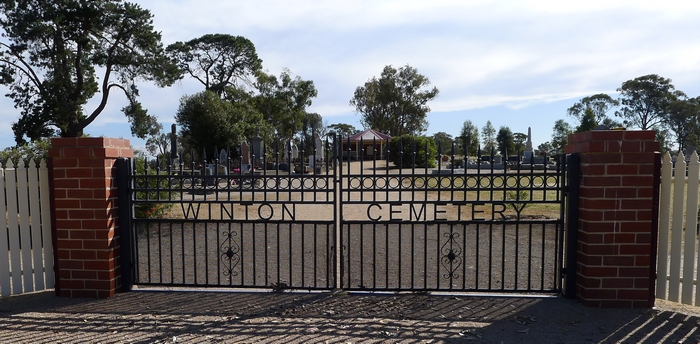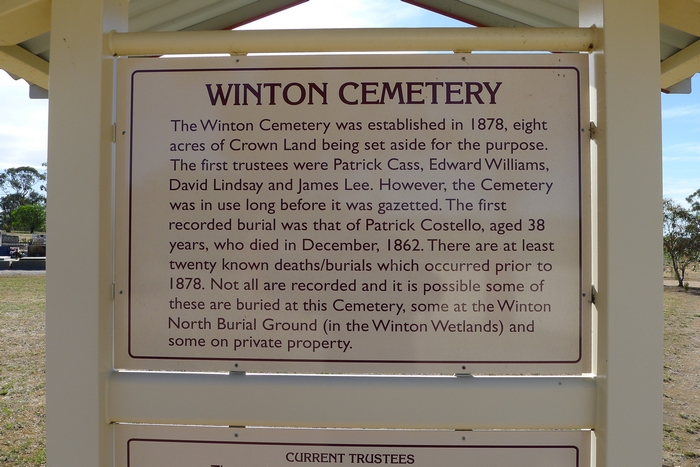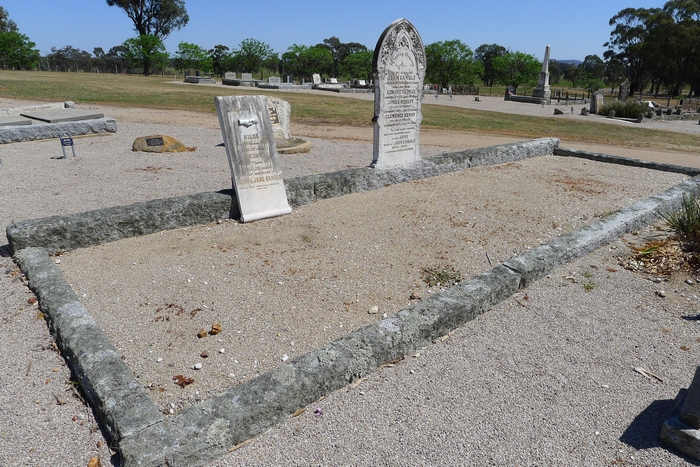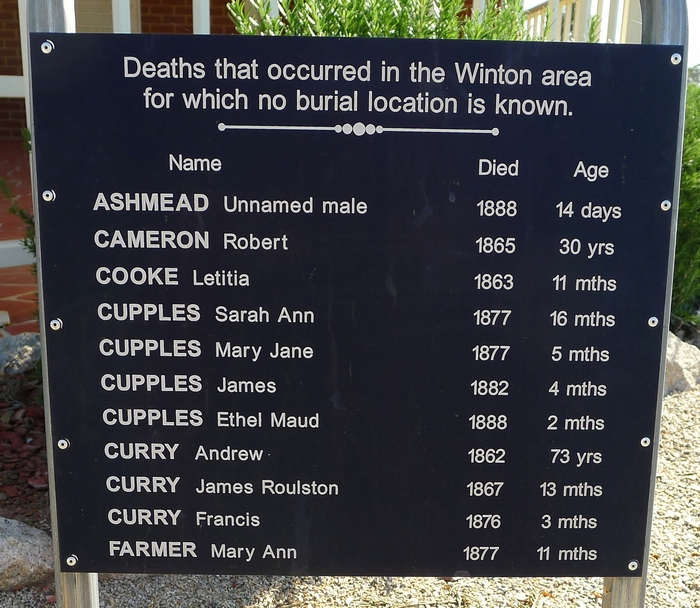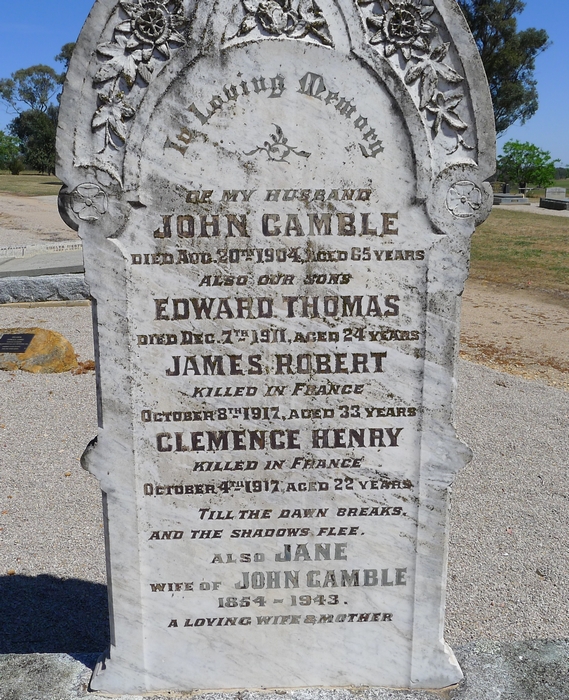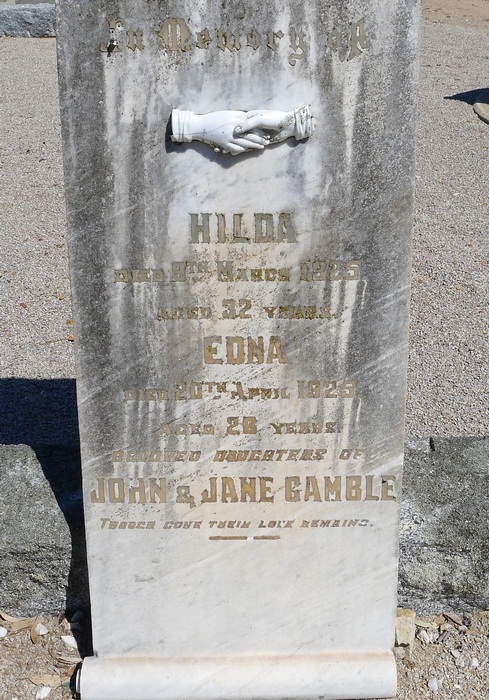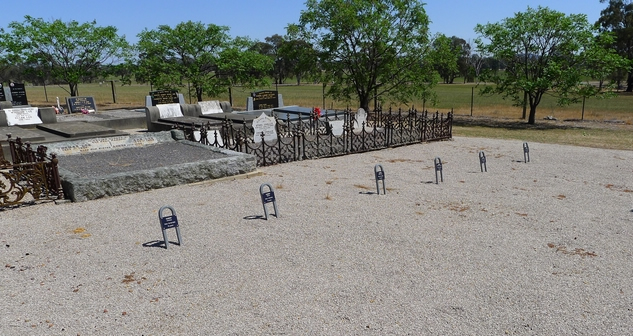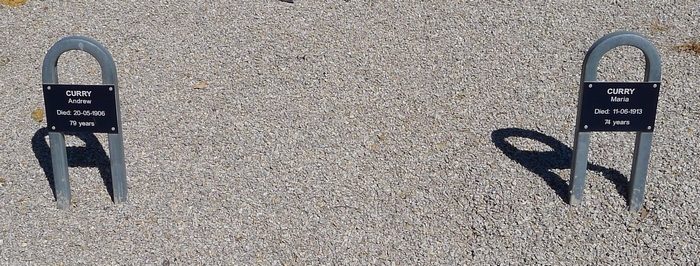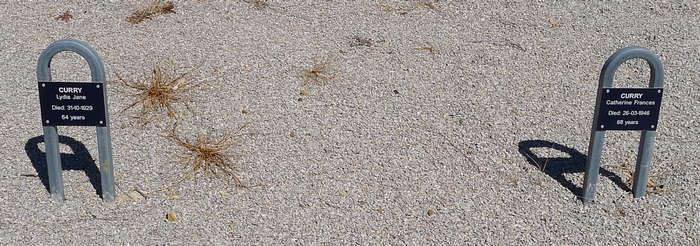Annie Currie’s Story
Annie’s paternal ancestors
Granny Smythe passed on the information that her grandfather, Andrew Currie (Currey, Curry) was related to Lord Belmore, the governor of the colony in her childhood. If so the family can be traced back to the early 1600s when the Tudor Kings, fearing that Spain would attack England through Ireland, confiscated land from the Irish on various pretexts and gave or sold it to their supporters including Curries and Roulstones with variations of spellings.
 Click for larger map
Click for larger map
John Corry of Dumfries and James Lowry or Laurie were among the "Planters" who settled in Northern Ireland from Scotland at the time. In 1656 John Corry bought Castlecoole, a property near Enniskillen, an attractive town set on an island in the River Erne. His great-granddaughter, Sarah, married Galbraith, the great-grandson of James Lowry, and inherited property from both families. The son of this union Armar Lowry-Corry MP for County Tyrone, High Sheriff, inherited Castlecoole and was created Baron Belmore in 1781, a few years later a Viscount and then an Earl.  He had built an elegant Palladian House, sparing no expense. It is considered one of Ireland's finest classical mansions*.
He had built an elegant Palladian House, sparing no expense. It is considered one of Ireland's finest classical mansions*.
Parklands run down to Lough Erne and greylag geese, descendants from a flock brought from Scotland in 1600s, abound on the water. The district is famous for its rural scenery, mountains, hills, lakes and many islands. Some members of the family took up Naval careers, one became Lord of the Admiralty.
It is not known exactly how we could be related to the Lowry-Corries. It is apparent that "our" branch of the family also originated in Scotland and many of the same names occur in both families.
From Granny Smythe's stories and recent research it has been established that Andrew and Lydia Currie lived in the north of Ireland about 1770. Prior to "Plantation" the area had been ruled for years by the O'Neills, the name Tyrone coming from "Territory of Owen" (O'Neill). Lord Abercorn who came from a very old Scottish family acquired most of the land around Strabane. It was divided into farms of about fifty acres each, by a network of tracks winding up and down the picturesque green hills. The farms were divided again into fields. The majority of people did not own their land, but paid a rent of about £18 a year to Lord Abercorn. Potato growing had facilitated subsistence farming and increased the family size on tiny holdings.
To promote the textile industry and reduce the reliance on potatoes farmers were encouraged to plant flax. This entitled them to a grant of machinery — looms or spinning wheels which gave extra income. On the spinning wheel list of 1796 the names Robert, Andrew and Sarah Currie appear in the parish of Ardstraw, near Newtown Stewart, a very pretty place where two good fishing rivers meet and the ruins of a medieval castle and the mansion and estate of the Duke and Duchess of Abercorn can still be seen.
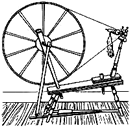
Robert had three wheels, the others one each, a wheel representing a rood (¼ acre, 1/8 hectare) under flax which grew well in the moist cool climate with plenty of organic matter in the soil. Longer stems meant better fibres. There were also Ralstons on the list and it is likely that they were related to the Curries. The name appears frequently in the family as Roulstone, most often James Roulstone. The Rollestones (Ralston, Roulstones) can trace their ancestry back to the Conquest. Another Robert Currie, pensioner (which suggests that he had served in the British Army probably in the Napoleonic War) and his wife "Ally" or Alice are in the Parish records at the nearby village of Sion Mills noting the births of their children in the 1830s.
In the late summer the flax was harvested by "pulling". It was then cleaned and "retted" to separate the fibres from the wood by soaking in dams, ponds, rivers or tanks for three days, before being dried and pulled through combs. Spinning and weaving were done mainly by the women or by the men after work, in the winter or bad weather. A good spinner (or spinster) was a very desirable bride. Irish linen became the chief product of Tyrone. After the day’s work it was usual to indulge in storytelling and singing for entertainment.
Farms had been continually subdivided for the sons until finally it became necessary to decree that only the eldest son could inherit, although this was not strictly enforced. Tyrone had an exceptionally large number of smallholdings. With the reduction of food crops, people became more dependent on potatoes, eating up to ten pounds a day, boiled, mashed, mixed with cabbage, leeks, onions, or kale. Porridge, hot or cold was eaten at every meal. It was usual for smallholdings to run a few cattle and pigs were a common adjunct.
Andrew and Lydia Currie are believed to have had three sons about 1800, the third of whom was also Andrew born at Newtown Stewart. As the third son he would not inherit the lease of the land rented from Lord Abercorn, and in fact made matters worse by marrying Ann (Nancy) Barr whose only recommendation was her beautiful singing voice, a great asset at social gatherings. They were cut off without a shilling and Andrew junior had to earn a living as best he could.
Every year on 12th May there was a big “hiring” fair in nearby Strabane. Farmers came long distances to pick their labour force for the next year. It is possible that Andrew worked in different parts of Tyrone where their children were born - Annie about 1820 at Ardstraw, Lydia about 1822, James Roulstone, 1st Jan 1823, Robert John a year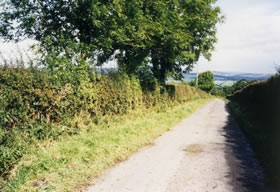 later at Strabane, Andrew at Gortlogher. Birthplaces may all have been Gortlogher, the townland, given as Strabane or Ardstraw on different documents. Gortlogher was a tiny village, Strabane was the Parish, Ardstraw the Poor Law Union. Or Ardstraw could have referred to the Parish in the Diocese of Derry, Barony of Strabane Lower, Poor Law Union of Strabane, all County Tyrone. The names of the children were of Scottish origin and they were raised with the traditions of music and stories.
later at Strabane, Andrew at Gortlogher. Birthplaces may all have been Gortlogher, the townland, given as Strabane or Ardstraw on different documents. Gortlogher was a tiny village, Strabane was the Parish, Ardstraw the Poor Law Union. Or Ardstraw could have referred to the Parish in the Diocese of Derry, Barony of Strabane Lower, Poor Law Union of Strabane, all County Tyrone. The names of the children were of Scottish origin and they were raised with the traditions of music and stories.
It is known that their father had learnt to weave. He also became a teacher, perhaps at nearby Inisclan. In 1831 an Irish National System of education was set up. All schooling was very basic, usually for two or three years, with the emphasis on rote learning, the teachers were untrained and older children mostly left school to work on the farms. Often the only book available was The Bible. More boys than girls attended, each paying a shilling or one and six a quarter. The salary for a teacher was £8 or £12. It was not seen as a desirable profession.
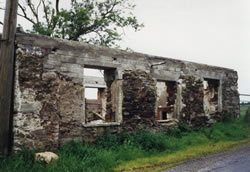 * Remnants were still there in 1992
* Remnants were still there in 1992 A small stone school building was constructed at Inisclan* in 1829, within walking distance of Gortlogher. This was a progressive idea to teach all children.
A spinning mill was set up at Sion Mills, which had originally been flour mills. The name Sion Mills comes from Seein meaning Hill of Fairies and inspired the hymn "All Things Bright and Beautiful". When the potato crop failed and the local people were dying of starvation and disease, many girls were eager to walk the miles to the factory by six each morning, often in bare feet, for an income of five shillings a week.
There were serious economic problems throughout Ireland and a devastating downturn in the linen industry on which many now depended. The farmers in the north had slightly more security, a reasonable rent and could sell the goodwill of the land. This did not apply elsewhere in Ireland. Without land their prospects in Ireland were poor. Many went to England or Scotland for the harvest season, others had to turn to the work houses in desperation.
Emigration
By 1841 the older Currie children were young adults and their mother, Ann, usually known as Nancy, had died. [On James' death certificate she is "Nancy Currie M.N. Barr"] Queen Victoria had come to the throne of England at the age of eighteen. People started to migrate in thousands to the “New World” in search of a better life. In ten years a million people died in Ireland and two million left, about 8% heading for the far distant and mysterious shores of the penal colony of New South Wales.
Most people who left chose to go to North America which was much closer and cheaper. Most migrants to New South Wales had some connection or were sponsored by someone already in the Colony who could reassure them.
It is possible that the family knew of Mark John Currie born in 1796 who became a young officer under Armar Lowry Corry. Mark John was captain and master on “Satellite” an 18-gun sloop in 1822 and sailed it to New South Wales. He led an exploring expedition which saw the later site of Canberra and snow-capped mountains to the south, keeping a diary of the excursion which was published in Britain. He had a property of 2000 acres near Goulburn called “Tyrone”. In 1829 he took his new wife and Governor Stirling to Swan River WA and became the first postmaster and harbour master. Their children were born in the next two years. Soon he left to resume his naval career and later became admiral.
Transportation of convicts had ceased and there was a labour shortage. Shipping agents advertised extensively in newspapers and with handbills looking for young, healthy, hard workers. Literacy was no asset. The Immigration Board paid £19 each to the shipping agent half on departure and half on safe arrival.
The four older children raised the money to travel to New South Wales on the "Margaret" as subsidised passengers. The girls were listed as native of Ardstraw, the boys of Strabane. They were all Protestants. Annie aged twenty-two and Lydia twenty were in the "protective custody" of their nineteen-year-old brother James. Robert was eighteen and considered independent being male. On the shipping form it stated that Annie was unable to read or write, but the others could read. Writing materials were very expensive, so many people learnt to read who could not write. Possibly Annie did not attend school at all. Farm labourers and domestics were sought after as immigrants, and it was as such that they applied.
The boys had to provide £2 each plus two complete sets of exterior clothing, six shirts, six pairs of stockings, two pairs of shoes and tools of trade in one trunk. The girls had to have six shifts, two petticoats, two pairs of shoes, sheets, towels, soap and luggage boxes plus £2. They also had to find the fare to Greenock, near Glasgow, Scotland, the port of embarkation, probably via Derry twenty miles away. Many people hired a cart for their luggage and walked behind it, carrying food for the journey. From Derry they went as deck passengers with no cover, hundreds crammed on a vessel. These costs and difficulties prevented the very poorest from migrating so most assisted migrants were the adult sons and daughters of small farmers. The possibility of returning to Ireland was remote.
A mattress and bedding were supplied and became theirs on arrival. During the 109-day voyage, in cramped and unhygienic conditions, twenty-three of the children on board "Margaret" died. Live chickens and sometimes sheep provided food, there was always pickled meat. Enough fresh water was a continual problem. Irish migrants found the diet too “rich” with more meat and less potato than they were used to. The welfare of the passengers was entirely the responsibility of the surgeon who set the daily timetable for meals, cleaning the decks and other activities. There were no ports of call to relieve the tedium but sewing, music and dancing on board "to prevent idleness and preserve cheerfulness". Their boxes were brought up routinely once a week. No doubt there were mixed feelings of boredom, hope and apprehension. In general it was a “vacation” from their normal heavy workload.
The four Curries arrived safely at Sydney Town in the heat of summer 1842. Every migrant vessel was met by Caroline Chisholm who organised suitable employment for girls and women. Annie was employed on trial for a week as a dairymaid at five shillings a week with J. Marshall, a stonemason of South Head Road, Sydney. Lydia was not engaged on arrival and had to stay at the Immigration Barracks. The brothers were employed as shepherds for six months at £7.10 each by James Marsden who also paid their fares to Goulburn. The journey would have been by bullock dray with station provisions, travelling at walking pace, taking at least a week.
Sydney Town had a population of thirty or forty thousand and was at the time beginning to suffer a Depression and many people went bankrupt in the next two years. Annie met Edmund Ludlow Clarke who had arrived four years earlier, aged thirty-five. He had a wife and two sons from whom he had separated. When his first wife died in 1860, she was buried in the Catholic section of the Cleveland Street cemetery.

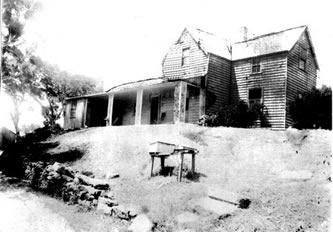 Clarke residence at Bondi
Clarke residence at BondiAlthough there is no evidence of a marriage certificate, Annie and Edmund had ten children in the next twenty years, first twins Lydia and Fanny born in 1852 when she was thirty-two, then Nancy (Ann), Bonus, Letitia and Justos, some were Currie names, others were most unusual. Edmund had become a barrister, active in the Supreme Court for some time, although his main occupation was dairying on a property near Bondi. The high sandhills blocked the flow of creeks and created wetlands, which dried up in the heat of summer. Edmund's dairy was a little north of these lagoons*. There were very few residents in the district as the early grants were of large estates but there were myriads of wildflowers also gum trees, wattles, casuarinas and ti-trees, bottlebrush and Christmas trees. Only later when land was resumed for public access, Sydney residents including the Clarkes discovered the now famous Bondi Beach.
Nothing is known of Lydia, whether she was eventually hired, lived or died, married or returned to Ireland. Caroline Chisholm conducted regular hiring days at the barracks, checking the credentials of prospective employers carefully. She then accompanied groups of girls to different places by bullock dray on a "walk and ride" basis. If Lydia had a de-facto relationship it would not be traceable. The name was perpetuated in the next generation.
The boys became farm workers in the Goulburn district, the road at the time described as “painful and dangerous” as it neared their destination, a bark-roofed frontier town, 150 miles [240 km] south-west of Sydney Town, and 2000 feet [600m] above sea level, making it very hot in summer and cold in winter. It is not known if Captain Mark John Currie of “Tyrone”, Goulburn, contacted them. They were shepherds for James Marsden, who owned a lot of land and was involved in various enterprises in the area. There was still a labour shortage and opportunities for anyone with capital and a venturesome nature.
This was "Outback", alien even to emancipists and in great contrast to the orderly little farms and many pretty villages of Tyrone, Ireland. The total white population of the Colony was still only half that of Tyrone and there were no elderly people.
At the time, there was a bad drought, frequent bankruptcies and growing depression. A Legislative Council was formed of twelve representatives nominated by Governor Gipps and twenty-four elected members, Goulburn's interests being looked after by the resident William Hovell. People argued about protection of aborigines, the proposed separation of Port Phillip Bay (Victoria) and the wishes of the pastoralists to have long leases of their properties.
Unclaimed letters for Miss Ann Currie and James Currie were advertised in the Sydney Morning Herald. Many letters did not reach their destinations. If only we could claim them now! Were they from Lydia? The following year a regular monthly postal service between the Colony and the homeland was set up.
Meanwhile the great potato famine caused by a new fungal disease, devastated Ireland. When the farmers came to harvest their crops they found they were all rotten. Each farmer found to his horror that his crop was the same. While the effects of the famine were less severe in Ulster due to its intrinsic industry and better rights for tenants, they were still dreadful. Tyrone was badly affected by the great famine of 1845-7. The population of 313,000 fell to 256,000— 28,000 dying and an equal number leaving. Fever hospitals could not cope with the number of sick and dying. Emigration led to larger farms, which resulted in agricultural reconstruction, less tillage, more livestock.
Whatever regret and heartache they may have felt about leaving their homeland, prospects were plainly better in New South Wales! In 1849 Andrew Currie, who gave his age as fifty-five but was probably five years older, and his son Andrew aged twenty-two and fifteen-year-old Mary sailed from Plymouth on the "Sea" to join the others. Shipping records stated that they could all read and write and there were two sons in Goulburn. It now seems likely that Mary was Mary Gamble who lived in Tyrone with her mother and two little brothers.
Andrew senior brought with him some of his school rolls, which showed his beautiful penmanship. As their ship dropped anchor in Port Jackson, a landmark on Flagstaff Hill (generally known to early settlers as Gallows Hill) was the old military hospital, which had been remodelled and had recently reopened as the first non-church school in the Colony based on the Irish National system. It took its name from the street running to Fort Phillip, which guarded the anchorage. The National Model School for children of all ages was to play an important role in the education of the Colony's children, the training of teachers and directly in the education of some of the Currie descendants. It was a pupil teacher system.
The population of the Colony had grown to 400,000, about a third coming from Ireland. Goulburn had doubled in size in the last four years, many of the newer houses being stone or brick, well designed and well built. By then there was also a gaol, a courthouse, a hospital, churches, flour mills and an immigration depot in the garrison town. While there James was required to go often to a property called Myrrhee, south of the Murray River to G Field’s and Doctor Crane’s station. In 1851 he camped nearby at Greta on Black Thursday, a day of terrible bushfires. Droughts and bushfires were utterly unknown to the Irish. He never again returned to Goulburn. He married Mary Gamble in December in the Scots Church, Melbourne in the newly separated state, given the royal name Victoria. At eighteen, Mary was ten year younger than James. She had been about ten when the four older Currie siblings had left Tyrone. The Curries may have sponsored her to come in 1849.
Gold had been discovered in NSW and Victoria and many hopefuls travelled along the road north. James joined the Bendigo gold rush and had a fair measure of success. Their first child Catherine Jane was born in Melbourne the following year.
Robert also left NSW about this time and settled at Laceby, near Greta. He was still a bachelor as were many men because of the imbalance of the sexes migrating.
Traces of gold were also found in many places including Plenty River, near Alexandra, north of Melbourne. Here was an opportunity for men with a bullock team and dray to supply stores and equipment for the prospectors, few of whom found fortunes. More prosperity came to those who had some capital and could supply the travellers and miners so the Curries decided to take this opportunity. First they had to acquire a bullock team and dray and learn how to handle it. Teamsters charged £1 a ton per mile. Small towns formed along the road, providing beds, meals, horse feed and tools. James carted for Samuel Shaw, merchant and gold-buyer of Beechworth, in the foothills of the Victorian Alps. It took at least three weeks from Melbourne to Beechworth, which became the Administrative Centre for the district and many beautiful buildings were constructed. Samuel Shaw left a large estate and named in his will the local hospital (the only one for many years between Melbourne and Goulburn) and the Benevolent Asylum (May Day Hills Psychiatric Hospital, later a nursing home).
In 1852 the population doubled as Australia became more desirable than US and people flooded into the newly established colony of Victoria. Corrugated iron arrived on the ships at this time – a simple, versatile and useful building material. In the chaotic times unshaven faces and irresponsible behaviour were the norm and a general breakdown of law and order. The Victorian police were regarded with contempt, especially on the diggings. People believed that the police allowed sly-grog selling, then "fined" the sellers, sharing the income. The simple buying of a licence was made very difficult.
The same year James' widowed mother-in-law Catherine Jane Gamble, arrived from Ireland on the "Mirzapore" with her two sons, John aged twelve and William, six as fare-paying passengers, possibly sponsored by Andrew senior. Many settlers sponsored family and friends, known as chain migration. Andrew married Catherine Jane in September in the Wesleyan Church, in Melbourne, two weeks after her arrival. Father and son had married mother and daughter. After experiences in many parts of the Colony they settled for a time at Plenty River. James and Mary seem to have lived in Melbourne, Beechworth, Upper Plenty and Whittlesea where he had a small farm while he was carting. Their second child was William John. James sold his farm and selected at North Winton.
Selectors
Although Australia was still largely unknown, land was being surveyed near Benalla in Victoria 150 miles [240km] north of Melbourne. The name Benalla came from the Aboriginal word meaning musk duck, a large speckled duck, which lives on lakes and swamps. The male has a large pendulous lobe under its bill. It also gives off an odour of musk when courting. The area had previously been described by the explorer Mitchell as a winding swamp, which gave him much difficulty. Numerous river red gums (Eucalyptus camaldulensis) grew along the banks of a river which was named Broken River because of the many islands which ‘broke’ the flow of the water. 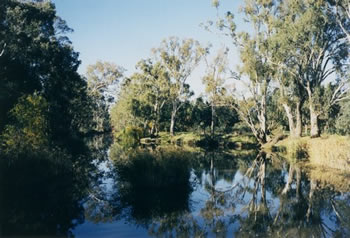 Hills surrounded it in the distance with the Victorian Alps to the east. Nearby Winton, also flat, low-lying and swampy was named by the surveyor after his homeland in Westmorland, England which could hardly have been less similar, the annual rainfall in the Victorian district being very irregular, many years quite hot and dry. The soils were also very thin and should have been treated differently but this was not understood in the early years of settlement. Land was usually ploughed by bullock team in preparation for planting and they had to learn about possible crops.
Hills surrounded it in the distance with the Victorian Alps to the east. Nearby Winton, also flat, low-lying and swampy was named by the surveyor after his homeland in Westmorland, England which could hardly have been less similar, the annual rainfall in the Victorian district being very irregular, many years quite hot and dry. The soils were also very thin and should have been treated differently but this was not understood in the early years of settlement. Land was usually ploughed by bullock team in preparation for planting and they had to learn about possible crops.
Many goods, especially imported and manufactured goods were very expensive, also labour and transport. Meat was cheap to farmers killing their own. Only the young and fit prospered.
By hard work and good management the Curries succeeded. The brothers James and Andrew occupied land at North Winton about 1855. Robert was not far away at Laceby. The purchase price was £1 an acre but the practice was to pay the deposit for three years after which they could buy if they had met the requirements for developing, or continue leasing. Title was given when the full purchase price was paid.
The three brothers and their father were now all in the area. Having grown up on farms, the Curries were now back on the land. This time they had a prospect of owning it. They found it possible to advance rather than just subsist. Selectors cut timber, built shacks, fenced, cleared, cultivated with axes and shovels and shot ducks for food. Framed houses with weatherboards were utterly unfamiliar to the Irish. They were described as upside down boats.
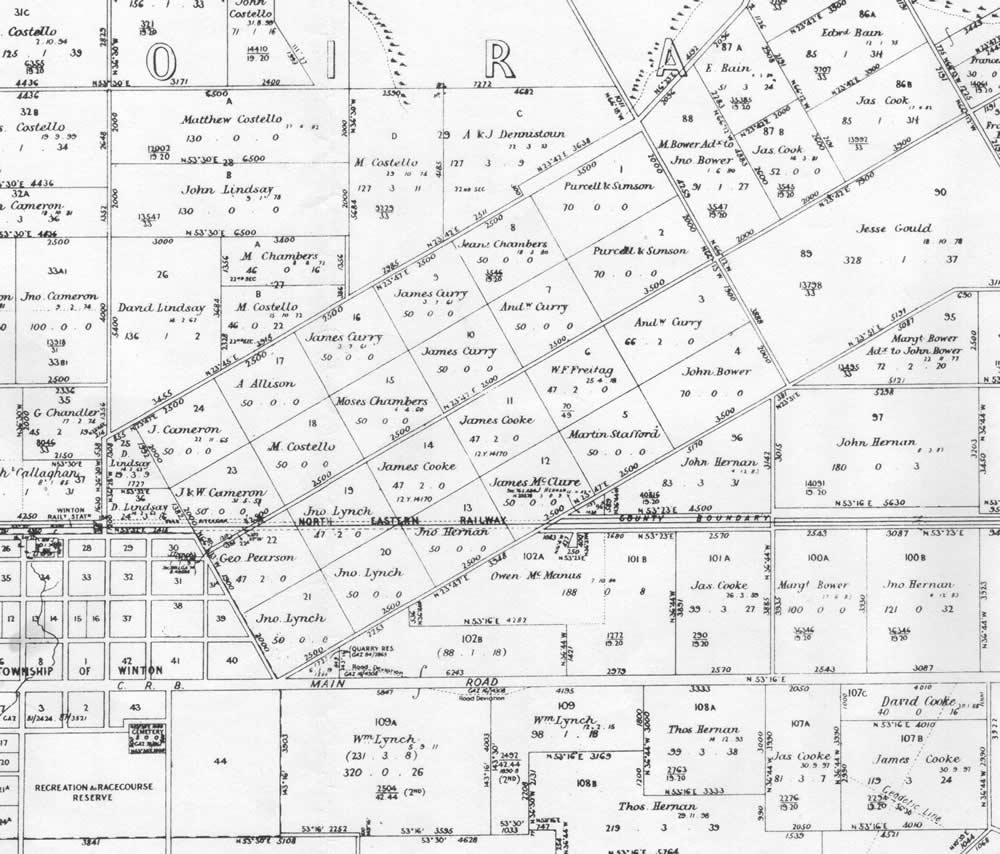 Click for larger map
Click for larger map
In 1855 the Crown held the first land sales for allotments, but it was six years before a Lands Office was opened in Benalla to facilitate the process. In the same year Benalla was gazetted a town and Cobb and Co began operations, Winton being the next "stage" north of Benalla on the road to the diggings at Beechworth. This greatly reduced the travel time as horses were used rather than bullocks, and were changed frequently in order to keep up a pace of about ten miles an hour. Imported coaches were used with the carriage hung on leather straps, which gave a smoother ride but could cause nausea. The service was reliable and they soon got the mail contract.
James had two blocks near Winton Swamp and another behind, along the road leading to Simson's each of about fifty acres, forming an L. His brother Andrew had one block of fifty acres and another 66.2.0 diagonally opposite. This subdivision was done before the survey and ran diagonally across the line of all the others which ran north-south. James is listed as having purchased land on 3rd July 1861. By now he and Mary had three more children, Thomas Arnold, James Roulstone (a Currie family name) and Robert Harold. Mary's young brother John Gamble also bought land nearby.
In these years there was a great surge of activity in the colony with 10,000 immigrants arriving in NSW and four times as many in Victoria. 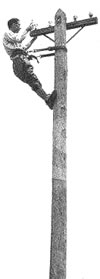 Towns, roads and railways were built, and the telegraph from Sydney to Melbourne was completed, going through Benalla.
Towns, roads and railways were built, and the telegraph from Sydney to Melbourne was completed, going through Benalla.
By this time in Ireland many landlords were changing traditional ways of life. Some, who had suitable clay on their land, had started potteries. The man who inherited the estate of Belleek west of Enniskillen found ingredients for pottery, so set up a factory employing his tenants, first producing insulators for the new telegraph extending through the country, and later fine porcelain which won awards. Belleek Pottery became the most famous in Ireland.
Many Winton settlers came from Ireland to escape the economic and political crisis. Some were related and made the voyage as a clan, bringing a lot of Irish culture to the area. Life was more independent but they maintained a keen sense of their Irishness. The traditions of music and stories were "portable" and so remained largely intact.
The Lawlors - Annie’s maternal ancestors
In the early 1800s, Cornelius Lawlor, a farmer and painter who may have had some Spanish blood, and Catherine (nee Bergen) lived in the south of Ireland where there had been more intermarriage of planters and native Irish and an acceptance of Irish customs. In 1839 their daughter Maria was born in Carlow, a town famous as a former Anglo-Norman stronghold. A hundred and fifty years earlier the ruins of a Norman castle were captured by Cromwell in a ruthless battle against the Irish. Forty years later William of Orange defeated the Irish again at the Battle of the Boyne, near the Boyne River further north. Carlow now had a fair population of Protestants including the Lawlors who celebrated the battle each year on July 12th, which became known as Orange Day. In Northern Ireland, fife and drum bands led parades from town to town; in the south it was a little more subdued. As a child Maria Lawlor was offered a shilling by her uncle to sing the provocative "Battle of the Boyne" which refers to William of Orange and the decisive defeat of the Catholic Irish. Maria, a spirited girl, obliged.
"Up to our knees in Papish blood
Up to our knees in water.
King Billy slew the Papish crew
At the Battle of Boyne Water."
In retaliation every window in the house was broken.
Maria and Andrew - Annie’s parents
Many Irish orphan girls and women from the workhouses came to the Colony, many from rural areas, who went into paid employment for the first time with no training in domestic service for the well-to-do. Prejudices arose about Irish girls in unsuitable employment. Many were so dislocated they looked forward only to the day when they would be reunited with their families in the next life. Some became farm workers and felt more settled.
When Maria was nineteen she came to Australia from Dublin on the “Ocean Home”. The main migrant depot in Victoria was at Geelong where Maria disembarked. At set times during the day, the various categories of migrants were interviewed by prospective employers looking for single men, single women, families.
Maria was “making her own arrangements” and was listed as literate and Church of England. At first she worked for Reverend Benjamin Hurst who had come to Geelong with Wesleyan missionaries and their wives from England to establish a church and Mission for Aborigines at Birregurra. The women found life very difficult and wanted female help especially for confinements. One of them died in childbirth, Mrs Hurst remained childless. Presumably she taught Maria the skills to become a general servant in Benalla Street, Benalla. She met Andrew Currie junior who admired her lively spirit. Two years after her arrival in Australia, Maria aged twenty-two and thirty-five-year-old Andrew, who had now been in the Colony for twelve years, were married at the home of his brother James at Simson's Road, North Winton. By now James and Mary already had four children. The Curries and Gambles from the same part of Ireland had a social network. Maria faced her new primitive circumstances with courage and as a challenge. Most of the day was occupied with work, carrying water, growing vegetables, tending animals, cooking, washing, and cleaning. Perhaps Maria was one of those who fitted better into the farming community than the town of Geelong and genteel society. Their only social support in a strange land and their only entertainment was what they made themselves. Most Irish people passed on stories and anecdotes they had learnt at home in the Old Country.
Their home on the property north of Winton was very basic, being little more than a hut. Snakes curled around the bare rafters at times. The area was known as Winton Swamp in wet weather, when it became a haven for birds, pelicans and herons and reputedly for bunyips. Many people heard the strange sounds from the swamp, a boom—boom—boom which resembled nothing known. The Aborigines spoke of bunyips, which emerged from the lagoons on moonlit nights to capture and eat humans, especially Aboriginal women.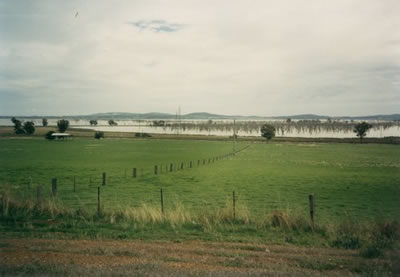 Dark and large with shiny eyes and a bellowing voice it was claimed to have been seen by many Colonists. It seemed the only possible explanation, although some thought it might be a seal, which were known to make their way up flooded rivers and get trapped at times. Eleven Mile Creek and Broken Creek flowed into the Swampy area, known officially as Lake Mokoan.
Dark and large with shiny eyes and a bellowing voice it was claimed to have been seen by many Colonists. It seemed the only possible explanation, although some thought it might be a seal, which were known to make their way up flooded rivers and get trapped at times. Eleven Mile Creek and Broken Creek flowed into the Swampy area, known officially as Lake Mokoan.
The Aborigines used Winton Swamp as a seasonal camping ground. Families collected stone implements, and cut down canoe trees. There were no Aboriginal massacres, no convicts, and to date no bushrangers.
Birth of Annie
The next year, 1862, a daughter was born to Andrew and Maria and named Annie like Andrew's mother (Nancy or Ann Barr) who had died in Ireland before the Curries migrated, also his oldest sister, Annie Clarke living at Bondi. The only medical attendant at the birth was Mary Currie, a nurse.
Life at North Winton
Three days later Andrew's father died of exhaustion from old age, after a week's illness aged seventy-three years. He was listed as a weaver and schoolmaster, born in Ireland, the informant for the death certificate being "John Gamble, son-in-law, [commonly used term for stepson] farmer of Winton", twenty-two-year-old son of Catherine Jane by her first marriage. The name of Andrew's first wife who had died in Ireland over twenty years before, and particulars are stated as unknown, issue of the marriage did not include the girls Annie or Lydia. John would certainly have known about his stepsister Mary Currie who lived nearby. There were five grandchildren in North Winton and nine at Bondi, the older ones now grown up. There may have been no contact with the Bondi cousins as their mother, Annie was illiterate and was not married so may have been disowned.
During the next few years Maria and Andrew increased their family with Lydia Jane, James Roulstone, who died in infancy, and Robert Ireland, all named after Currie family members. Maria did not show a fear of anything, Aborigines or even bulls, once having to fight a wild bull with a pitchfork. On another occasion Maria and the little ones were "captive" when a bull from a nearby property got into a fight with the family bull and fought and struggled around the hut. Maria needed all her strength and courage to survive. She found inner reserves of both.
Dairying and poultry were the mainstays of the farm. Young Annie learnt to ride and preferred to be in the fields with her father rather than in the house with her mother who was impatient and sharp-tongued. Whatever needed to be done on the property would be observed and learnt by Annie. As the second child was also a girl, Annie did “boy’s” jobs as soon as she was big enough.
School was conducted in the home of a widow-lady, probably Adelaide Hennessy, who lived four miles away. The Curries had a great respect for education and were keen for their children to attend, although they also needed all the help they could get on the farm. Annie often had to work in the morning before school and was sometimes so tired that she fell asleep in class. The teacher did not wake her. There were no books, readers or primers, only the newspapers and the children learned to read them.
They left their lunches on the veranda of the old building where the teacher's hens and pigs wandered around. One day a boy looked out of the window and called out "Pig's got my lunch!" The children ran out and chased the pig but the lunch could not be retrieved. However there had been an interesting diversion and after that the children took turns to sacrifice their lunch by leaving it near the broken boards where the pig could reach it - until the teacher had the gap boarded up.
Church services were held at the Currie's house. Early local preachers included Andrew and James. Scottish families appealed to the headquarters of the Presbyterian Church for aid in building a church and maintaining a minister. Their appeal was refused and the people turned to the Primitive Methodists (one of five kinds which flourished at the time). A small chapel at Winton was sanctioned to be known as Bourne Bank, Curries' Hill, a slight rise. Andrew donated land and £5 towards the cost of a church. James Currie donated £1 and so did John Gamble. The expense in the erection of the church amounted to £60, voluntary labour being credited with £15, land £5, while the timber used in construction cost £22/13/9. A small church was erected and the congregation became Methodists. Methodists believed in education and sobriety. In 1862 Mr Currie had been appointed Society Steward for Winton and later a prayer leader. The existence of a church was a place of social contact and showed the difference between the wilderness and civilisation.
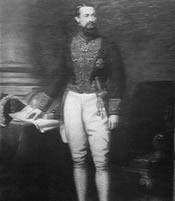
Between 1867 and 1872 the governor of NSW was Lord Belmore, a descendant of John Corry of Castlecoole. He had been educated at Eton and got his Master's degree at Cambridge. He took on the governorship as Castlecoole was heavily mortgaged. On a tour of the South in 1868 he passed near the area in which the Curries lived. Young Annie was told she was the same clan or family group. In a speech in May 1869 at Goulburn at the opening of the railway, he spoke of his convictions about the value of trees and of railways. Lady Belmore planted an oak tree in the middle of the market square, which was renamed Belmore Park. The tree was destined to dominate the park. The Belmores revisited Goulburn before leaving Australia.
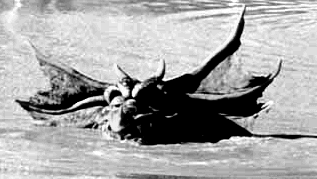
At North Winton in 1870 there was a very bad flood. Eleven Mile Creek and Broken Creek flowed into Winton Swamp and “bunyip” stories increased. The shire put in a drain, which Andrew felt was badly constructed and which he said caused flooding on his property. The children often had to rescue marooned stock and poultry and came home wet. The drain was later cleaned out but the construction was not altered. The shire contended that it was all right and that the flooding came from the natural flow of water. Andrew sued the shire and in an appeal to the Supreme Court won, but obtained no damages. Until now the Seven Mile Creek and Winton Creek ran all year. Suddenly the rainfall fell from thirty-one inches to twenty-five inches, which was thought to be caused by the cutting down of all the trees.
By then Andrew was paying rates on 120 acres, James on 150 acres and John Gamble on 240 acres. After about six years at North Winton, James sold his property and bought 550 acres at nearby Greta which although it was flat, would not be troubled by flooding, and where he was involved with Greta Methodist Church.
In spite of primitive conditions the Curries encouraged high standards of behaviour and an interest in literature and learning. Whenever it was possible they obtained copies of the classics. Andrew wrote verses and plays for the local children to recite and perform at the Sunday School Anniversaries and at Christmas. The children heard the stories of Ireland from both their mother and father and these would be repeated to the next generations, not necessarily without embellishments. They were also shown the school rolls, which their late grandfather had brought with him from Ireland. All were written in his beautiful copperplate handwriting and were treasured. Music was also important.
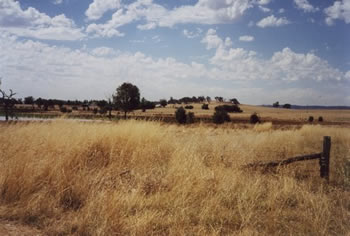
When Robert was old enough to start school, Annie aged about ten often had to piggyback him on the way home, as he got tired on the four-mile walk. There was sometimes friction between the two. At home there were the afternoon chores to be done by Annie and Lydia. Chaff had to be cut to feed the cows, and eggs collected and hens fed. Andrew (Andy) and Edmund Arthur (Arthur) were added to the family. Their Greta cousins were increased by the arrival of Annie, Lydia Mary, Matilda and Frances to James and Mary, totalling nine children.
It was decided to move the church to a more convenient position at North Winton where a grant of land was received from the government. It had been at Curries Hill for three years. The local paper reported, "The removal of the church was undertaken in 1871. Whilst en route, the bullock team bolted with their load, fortunately finishing up at the bottom of the hill without any damage being done."
The nearby town of Winton, "a place with a future", had a school, blacksmith's shop, a butter factory, racecourse, railway siding, mainly for firewood, hall and hotel. The post office was an area set aside in a store. It was a "rising township" of thirty, one of many townships along the road, spaced at about seven mile intervals, (a stage) the distance that Cobb and Co liked their horses to travel before being changed.
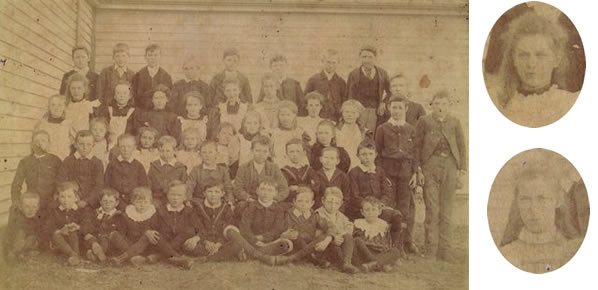 Winton School ca 1885, Allie and Fanny
Winton School ca 1885, Allie and Fanny
There were many other Irish people in the district including the Kelly family considered by the Protestant Irish to be horse and cattle thieves and "Bog Irish Catholics", labouring people. Ellen Kelly recently widowed, settled at Eleven Mile Creek four miles east of Winton, with seven young children on a four-acre selection near her family at Greta. A hard worker and intensely loyal she had a sharp tongue. In town her older sons became known as the Greta Mob. At times the Gambles employed some of the older Kelly children although they knew they were fiercely anti-Protestant. The Currie children were warned to be wary. When Annie was about ten Ned Kelly rode into the street in Benalla where she was playing while her mother shopped. Everyone else had disappeared on his approach. He said to her "Don't worry. I don't hurt little children." On another occasion Robert was in a wheat field with some friends when some horsemen came up. When they realised it was the Kelly Gang, they dived into the field to hide. Their cousin Catherine had also met Ned on the way to school.
One day Annie and her father were riding around the hills looking for some strayed cattle when they met Ned and asked him if he had seen the cattle. Ned was defensive. "Your daughter rides around these hills, I have never touched her. I wouldn't touch your cattle either." He indicated in which direction they should look.
At the age of fifteen Ned was gaoled for three years. In 1874 he was released and worked honestly for two or three years as a timber-getter and sawmill hand for R. Rule in the only steady job he had. The same year James' daughter Catherine Jane, aged twenty-two, had married Samuel John Rule.
A good horseman who liked to do stunts on horseback, and an excellent shot, Ned grew to be six feet [1.82m] tall. The Kelly Gang had many supporters especially among people who despised the police as not worthy of respect, and who felt that the Kellys and others were hounded. Ellen Kelly remarried.
The Rules supplied sleepers for the Melbourne to Sydney railway through Benalla and North Winton near Andrew’s property and Ned became a foreman. When the operation was transferred to Gippsland, Ned returned to his former association and began stealing horses with his stepfather on the Murray River and around Winton. Constable Fitzpatrick drank heavily at the Winton Hotel before going to arrest Dan at the Kelly house, where the policeman's wrist was injured. Fitzpatrick went back to the hotel and knocked up the publican after midnight for a drink. The doctor was very dubious that his wound came from a bullet. Following this incident, regardless of the fact that she had a small baby, Mrs Kelly, on the evidence of Fitzpatrick, was gaoled for harbouring a criminal. Kelly embitterment and grievance snowballed to the point of enragement. A short while later Fitzpatrick was dismissed as untrustworthy.
Ned was working for a neighbour of the Currie family. During a busy time Annie, aged about 16, was also helping out. The hut in which the girls slept had chinks between the slabs. The girls always blew out the candle before undressing.
In 1876 a timber schoolroom, twenty-four feet by sixteen feet [7 x 5 m] with two attached rooms for the teacher, was built at North Winton after an application by the Curries and others. Adelaide Hennessy, who had conducted school in her home, had been an independent woman often at variance with the official attitudes of the day. One applicant (parent?) asked that she not be appointed as head teacher, adding "nothing personal". Schooling was very basic with nothing supplied – no books, pencils, readers etc and all grades in one room.
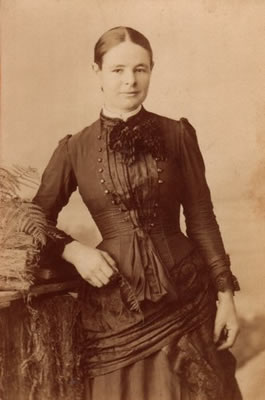 Annie Currie aged about 16
Annie Currie aged about 16 By now Annie had left school. She had developed skills as a raconteur. After elementary education, children worked for their parents, on the farms in rural districts. After the evening meal there was time to listen to books being read aloud, stories told, poems recited, songs sung or composed. Young Robert learnt to play the violin.
Cops and the Kelly Gang was the theme of a lot of play among the younger children.
The next year at Jerilderie, a town in western NSW there was the famous hold-up and the letter written by Ned setting out his grievances. Annie's Uncle James, who had moved to Greta, had bought a plough. One night the blade disappeared mysteriously. They believed it had been turned into armour. In 1880 Ned was caught and taken to Beechworth gaol. Because of widespread local public petitions for leniency he was tried in Melbourne and hanged. When Mrs Kelly returned to Benalla she entered a store where Maria was shopping. The customers all fell silent. The atmosphere was tense. Ellen Kelly spoke out proudly "They hanged a MAN in Melbourne. I am proud of my son and I am proud of the way he died."
In the meantime Alice Maria (Allie), Catherine Francis who died in infancy, another girl of the same name, (Fanny) and another James Roulstone (Rollie) were born to Maria and Andrew. Most of these are family names, and even the nicknames follow family traditions*. The babies who died were buried in graves on their land. In 1877 Andrew's brother, Robert of Laceby, near Greta, died aged fifty-three, unmarried, as far as we know the first of the siblings to die.
Their Aunt Annie in Sydney was widowed in 1883 when their Uncle Edmund died, the property at Bondi known as Clarke's dairy was later subdivided, and streets were named Bonus, Justos and Nancy the same as some of their children. They were considered to be practical types of people. The family graves are to be found at South Head Cemetery.
One day in North Winton, Maria scolded her young adult daughter, Annie, in front of visitors and slapped her face. This Annie found intolerable. Also strong-willed, Annie decided to leave home and make her own way in the world. She went to Melbourne and got a job as a servant. In time she met Ted Smith.
* * *
Graves at Winton
NEXT >>


 He had built an elegant Palladian House, sparing no expense. It is considered one of Ireland's finest classical mansions*.
He had built an elegant Palladian House, sparing no expense. It is considered one of Ireland's finest classical mansions*.

 later at Strabane, Andrew at Gortlogher. Birthplaces may all have been Gortlogher, the townland, given as Strabane or Ardstraw on different documents. Gortlogher was a tiny village, Strabane was the Parish, Ardstraw the Poor Law Union. Or Ardstraw could have referred to the Parish in the Diocese of Derry, Barony of Strabane Lower, Poor Law Union of Strabane, all County Tyrone. The names of the children were of Scottish origin and they were raised with the traditions of music and stories.
later at Strabane, Andrew at Gortlogher. Birthplaces may all have been Gortlogher, the townland, given as Strabane or Ardstraw on different documents. Gortlogher was a tiny village, Strabane was the Parish, Ardstraw the Poor Law Union. Or Ardstraw could have referred to the Parish in the Diocese of Derry, Barony of Strabane Lower, Poor Law Union of Strabane, all County Tyrone. The names of the children were of Scottish origin and they were raised with the traditions of music and stories. 



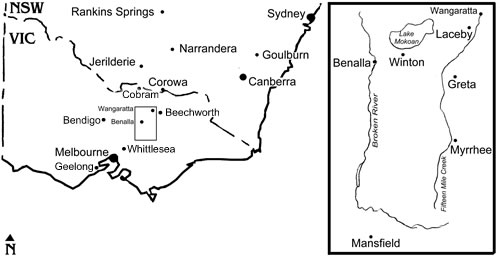
 Hills surrounded it in the distance with the Victorian Alps to the east. Nearby Winton, also flat, low-lying and swampy was named by the surveyor after his homeland in Westmorland, England which could hardly have been less similar, the annual rainfall in the Victorian district being very irregular, many years quite hot and dry. The soils were also very thin and should have been treated differently but this was not understood in the early years of settlement. Land was usually ploughed by bullock team in preparation for planting and they had to learn about possible crops.
Hills surrounded it in the distance with the Victorian Alps to the east. Nearby Winton, also flat, low-lying and swampy was named by the surveyor after his homeland in Westmorland, England which could hardly have been less similar, the annual rainfall in the Victorian district being very irregular, many years quite hot and dry. The soils were also very thin and should have been treated differently but this was not understood in the early years of settlement. Land was usually ploughed by bullock team in preparation for planting and they had to learn about possible crops.
 Towns, roads and railways were built, and the telegraph from Sydney to Melbourne was completed, going through Benalla.
Towns, roads and railways were built, and the telegraph from Sydney to Melbourne was completed, going through Benalla.
 Dark and large with shiny eyes and a bellowing voice it was claimed to have been seen by many Colonists. It seemed the only possible explanation, although some thought it might be a seal, which were known to make their way up flooded rivers and get trapped at times. Eleven Mile Creek and Broken Creek flowed into the Swampy area, known officially as Lake Mokoan.
Dark and large with shiny eyes and a bellowing voice it was claimed to have been seen by many Colonists. It seemed the only possible explanation, although some thought it might be a seal, which were known to make their way up flooded rivers and get trapped at times. Eleven Mile Creek and Broken Creek flowed into the Swampy area, known officially as Lake Mokoan.




